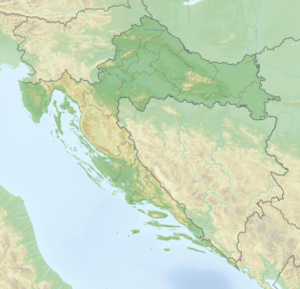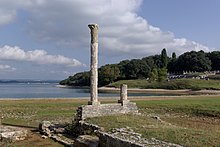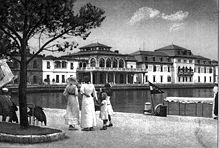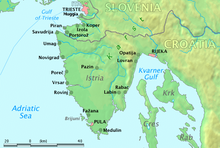Brijuni
| Brijuni | ||
|---|---|---|
| Waters | the Adrian Sea | |
| Geographical location | 44 ° 55 ' N , 13 ° 46' E | |
|
|
||
| Number of islands | 14th | |
| Main island | Veliki Brijun | |
| Total land area | 7,234.9 km² | |
| Residents | uninhabited | |

Brijuni ( Italian Brioni ) is a small group of islands in the Croatian Adriatic . It is located off the coast of the historical region of Istria, 12 km from the center of the coastal town of Pula and belongs to the village of Fažana.
The archipelago consists of 14 individual islands and is under nature protection. The total area of the park, which was founded in 1983, is 33.9 km² including the surrounding water. Only the largest island, Veliki Brijun , can be visited, but only either as a visitor on a guided excursion tour or as a hotel guest. The old Austrian fort on Brioni Minore (Mali Brijun) has already been the setting for theater performances in the past few years and could be visited on these occasions. In 2015/16 a nature trail was set up there about quarries, which is not yet accessible to the public because there is no infrastructure for visitors. On the other islands there are some state-owned and private properties that are guarded.
The Brijuni archipelago can be reached by boat from Fažana or Pula. Mooring with private boats is only permitted in the harbor on the main island. In addition, diving in the national park is only permitted from licensed diving centers.
history
There are remains from all epochs - starting with the dinosaurs that have left their mark in several places on the island. They were theropods , similar to the Allosaurus . The islands were already inhabited in prehistoric times. Archaeological traces indicate a first settlement around 3000 BC. Chr. The ruins in the Val Catena Bay / Uvala Verige date from Roman times. The largest villa maritima in the Adriatic Sea extends over a length of more than a kilometer , which was created around the Claudian era from two villae rusticae , probably from the late Republic . A large residential building with terraces, a small temple district with three temples, a priest's apartment with a boragang, cisterns, a bathing area ( balnea ) as well as a farm wing with wine and oil production and a dye works. Seven villae rusticae as well as a saltworks and several stone quarries can be found throughout the archipelago in Augustan times . The Byzantine castrum also emerged from a villa rustica and served as the only fortified settlement on the island to protect against pirates from around the 5th century. The early Christian basilica of St. Madonna and the remains of the church of St. Peter are nearby. In the center of the island there is a fort from the Venetian era with a defense tower and the St. Germanus Church with copies of the frescoes from Beram and Glagolitic writings . The islands became part of the Austrian coastline until 1797, when they were Venetian . In 1866, Admiral Wilhelm von Tegetthoff assembled the Austrian fleet in the Fažana Canal and led them from there into the naval battle of Lissa (today Vis ).
In 1893 the Austrian industrialist Paul Kupelwieser bought the islands and made them habitable. The reason for the “uninhabitable” was malaria . Kupelwieser read in a newspaper that Robert Koch wanted to do research on malaria in Italy and offered him the island for experiments. Koch was very interested, first sent two doctors and soon afterwards came himself. Blood was taken from all residents and workers on the island, which was first examined with a rapid test and then sent to Berlin. The malaria carrier was the abundant Anopheles mosquito . The eradication of malaria took place through several actions, namely the consistent examination of all people on the island ( above all workers, some of whom came from the Capodistria prison , and of course the residents), the treatment of all infected with Chininum muriaticum, the examination of all cisterns and rain barrels and the rehabilitation of the ponds with petroleum. This prevented the multiplication and thus favored the reduction or migration of the mosquito. The treatment concept for the sick was well organized, in the cold season the disease could be cured and the mosquitoes then found no more sick, the bites could no longer infect anyone. A monument still commemorates Robert Koch's visit to the island (by Josef Engelhart 1902).
Kupelwieser laid out walking paths and protected “Boraplatzln” in the old quarries, and ran agriculture and dairy farming (“Imperial cheese ”) and viticulture . Alois Zuffar was responsible for the botanical equipment, its pine and cypress avenues still delight visitors today. Anton Gnirs rendered outstanding services to the excavation of the Roman remains. Kupelwieser imported exotic plants and animals, built hotels, had a submarine water pipe built, relied on the most modern technology and made the island ( Hermann Bahr 1908: "I was always looking for an island and only ever found islands until I came to Brioni ...") to a fashionable health resort. In 1913 the first winter swimming pool was built on the Austrian Adriatic. In the time before the First World War , they were a meeting place for the nobility, industrialists and the upper class, and numerous artists also visited the island. Tennis, horses, swimming and sailing, natural aromatherapy, and the salty, dust-free air ensured good relaxation. Many regular guests stayed for several months each year. With the help of Carl Hagenbeck, he laid out a zoo with monkey canyons, an ostrich farm, enclosures with antelopes and a pond with flamingos. During World War I, the island submarine - Base of the Imperial and Royal Navy .
From 1918 to 1943 Brioni belonged to Italy and became an international meeting place for sports enthusiasts: there was what was then the largest golf course in Europe, polo events and regattas. The elaborate keeping of polo horses for any interested guests, together with high taxes, then led to financial difficulties, as a result of which Paul Kupelwieser's eldest son Karl shot himself to death in 1930. It went further downhill until the Italian state took over the heavily indebted island. After Italy surrendered in 1943, the Germans came. Therefore, the islands were bombed in 1945 - the seaside resort of Saluga and the observation tower made of Witkowitz iron on Monte Carmen were destroyed, almost all buildings in the port area were badly damaged, the hotels Neptun I and Neptun III . After the Second World War , the islands came to Yugoslavia and, like most of Istria, became part of Croatia.

From 1947 on, the Yugoslav state and party leader Tito had one of his preferred residences here , making the entire archipelago forbidden to the ordinary population. The remains of the old buildings were z. T. demolished, z. T. rebuilt and renovated. Tito welcomed state guests and numerous Hollywood stars with pleasure and often on Brijuni. In 1956, the then President Tito also signed the agreement for the establishment of the non-aligned states together with Presidents Nehru and Nasser on the island, which is referred to as the Brioni Declaration . After Tito's death in 1980, the islands became a national park . The island of Veli Brijun is still used by the Croatian government for state receptions and as the summer residence of the Croatian President.
On Veli Brijun, the Brioni Declaration in 1991 ended the 10-day war in Slovenia with Belgrade.
The islands
The individual islands always have a Croatian and an Italian name, as does the entire archipelago with their official name Brijuni and the Italian variant Brioni . The reason is the eventful history of the islands, their changing rulers and the proximity to Venice , which had Istrian islands in its possession for over 400 years.
- Veliki Brijun (Brioni Maggiore) is the largest of the islands with 5.723 km², it is located 2 km from the Croatian coast.
- Mali Brijun (Brioni Minore) has an area of 1.0746 km² and can be visited in the course of theater performances in the castle.
These two main islands together take up around 94 percent of the total area of the archipelago. All islands of the archipelago at a glance:
![]() Map with all coordinates: OSM | WikiMap
Map with all coordinates: OSM | WikiMap
|
The island of Sv. Jerolim (see map) can be entered today as part of organized island tours with a swim stop, this was also the case with Brioni Minore at times. All other islands are inaccessible, Gallia could be rented expensive a few years ago. Vanga, Tito's private island, can sometimes be visited in an organized manner.
tourism
Since 1985 the main island can be visited again by tourists . The starting point is the port of Fažana. Short visitors can expect a guided four-hour island tour with an electric train (also through the safari park) and a visit to the St. Germanus Church with copies of the frescoes of Beram, a museum with stuffed animals that were given to Tito and a Tito museum that is now also houses a room in memory of Kupelwieser and Koch. Depending on the time, breaks are planned in the Byzantine Castrum or in the Roman Bay. Hotel guests can enjoy the sunrises and sunsets, the diverse nature, e.g. B. watch the numerous peacocks and seagulls.
In 2015, the old boathouse in the harbor, an interesting building by Eduard Kramer, a student of Otto Wagner, which was the home and practice of the spa doctor Otto Lenz from 1906 to 1938 , was renovated and the educational center was set up. Topics are the history of the island, the Lenz family, famous visitors, fauna and flora, the sea and environmental protection. There is a slide show of all 14 islands in the archipelago
For many years, efforts have been made to turn the islands into an exclusive refuge with the help of foreign investors (especially the Italian fashion house Brioni ). After starting to play polo and hold horse races again years ago , the plan is to build an 8,000 square meter "wellness center", casino , golf hotel , restaurants and 5-star hotels . These plans are criticized, among others, by environmentalists and the island's regulars. In the meantime, the Brioni company has withdrawn because the status of National Park and National Memorial stood in the way of all changes. This now seems to change after Croatia's accession to the EU . If one really only wanted to set up a “Brioni Riviera” on the mainland and spare Brijuni, it was said at the beginning of 2014 that extensive work on the island should start as early as August. The responsible minister announced that “something was coming that has never happened before”. In the meantime it has been carefully renovated.
flora

There are around 680 plant species on the islands, many of which are endangered in the rest of Istria and can develop freely here. The large oak forests are known . In addition to various indigenous Mediterranean species such as holly , myrtle , strawberry trees , mastic shrubs , manna ash or common heather , imported species such as pine , various pines and cedars such as Lebanon cedar , eucalyptus , fir , sequoia or cypress also live here . Exotic plants such as palm trees and cacti are also generously planted. The so-called ancient olive tree ( 44 ° 54 ′ 52 ″ N , 13 ° 46 ′ 4 ″ E ) is a special attraction . Using the C-14 method , it was determined that it is around 1600 years old.
fauna
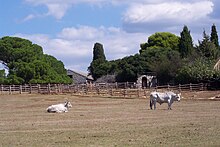
Over 250 species of birds, such as rare cormorants , can be found here. A bird sanctuary was set up in a salt works. Wild hares and imported deer , roe deer and European mouflons can be found on the island . The island is populated by countless peacocks, lizards, owls, gulls and cicadas.
One of the biggest attractions of the islands is the safari park in the north of Veli Brijun; elephants , llamas , zebras , Nilgau antelopes , Somali sheep, sacred Indian cows, donkeys and ostriches have been presented here since 1979 .
Since the death of the elephant Sony in the spring of 2010, its conspecific Lanka has been alone. There is also an Ethno Park, where a typical Istrian farm with Istrian oxen ( Boškarin ), Istrian sheep (Pramenka), donkeys and goats are presented.
Filmography
- Brioni - island of millionaires. ORF - dokFilm by Thomas Macho with Erwin Steinhauer as island guide. 54 minutes, first broadcast on December 30, 2018 on ORF 2 .
literature
- Brioni Insel-Zeitung , February 1910 to December 1913. ( All editions 1910–1913 .: Brijuni (online at ANNO ).).
- Helene Stökl : Brioni and Arbe. With nine illustrations based on photographs. In: Reclams Universum, 28.2, 1912, pp. 927-932.
-
Paul Kupelwieser : Brioni. From the memories of an old Austrian. 1919 (German and Croatian)
- Reprint of the 5th chapter as: Paul Kupelwieser, Nataša Urošević (transl.): Brioni. From the memories of an old Austrian / Iz sjećanja starog Austrijanca . Amforapress, Pula 2005, ISBN 953-6453-06-1 .
- Otto Lenz: Walks on Brioni. Vienna 1926.
- Maria Lenz-Guttenberg: Paradise lost. Opatija 1946.
- New edition as: Maria Lenz Guttenberg, Mira Pavletić (Ed.): Izgubljeni raj. Brijuni. (In Croatian translation from: Lost Paradise Brijuni. ) With a foreword by Mira Pavletić ( Svijet Marije; The World of Marie) and the biographies of people mentioned in the manuscript, especially Brijuni guests ( Osobe, Slike, Documenti Vremena ; People, pictures, documents of the time). Antibarbarus Editions, Zagreb 2007, ISBN 9789532490299 .
- Manfred Mautner Markhof : Stops and stations in my life. Guardaval Handels- und Verlagsgesellschaft, Vienna 1978. Here: Brioni - Paradies auf Erden, pp. 27–34 ( full text online , January 2018, accessed on August 26, 2019).
- Franjo Radisic: Brioni. History, culture, art, tourism, natural attractions. Zagreb 1985.
- Hans Werner Sokop , Heinz Richard Berger (Ill.): Brioni. Poems from Istria. Vienna Protected Workshops, Vienna 1991.
- Hans Werner Sokop, Heinz Richard Berger (Ill.): Poems in Haiku rhythm about Brioni. 17 tours. Vienna Protected Workshops, Vienna 2002.
- Heinz Waldhuber, Katrin Kruse : Aristocratic chic on the island of Brioni 1893-1919. Böhlau, Vienna 2006, ISBN 3-205-99500-7 .
- Hans Werner Sokop: Always to Brioni. Istrian sonnets. Vindobona, Horitschon 2009, ISBN 978-3-85040-000-8 .
- Mario Bloier: The diving archaeological investigations in the Val Catena bay on Brioni [Istria / Croatia] 1996/97. Findings and finds. [= Passau university publications on archeology, 14]. Marie Leidorf, Rahden / Westphalia 2012, ISBN 978-3-89646-181-0 .
- Brigitte Breth: Paradise and restricted area. The Austrian industrialist Paul Kupelwieser bought the Istrian Brioni Islands 120 years ago. In: Wiener Zeitung , weekend edition 29./30. June 2013 ( Article online. In: Wissenssammlungen im Austria-Forum , May 30, 2016, accessed on August 26, 2019).
- Florentina Welley: What zebras do on the Adriatic. On the island of Brioni, off the southern tip of the Istrian peninsula, you will find hotels with K&K charm & bohemian chic, zebra herds, an orphaned zoo, a Tito museum, a golf course, wonderful beaches and finds from the island's history, the go back to Roman times. In: Kurier , June 2, 2015 ( article online , accessed August 26, 2019).
- Georg Markus : Brioni - The island of millionaires. The island was developed by a Viennese, was owned by the Mautner Markhof family and is now a vacation paradise. In: Kurier, December 30, 2018 ( article online , accessed August 26, 2019).
Web links
- Brijuni National Park - official website.
- Brioni's story: Belle Époque holiday paradise. Extensive documentation with historical recordings and plans. In: dynastiemautnermarkhof.com. Portal family chronicle Mautner Markhof.
- Brijuni before Istria. In: ESYS - European Sailing Information System, online port manual Croatia.
- The Brioni (Brijuni) National Park. In: Istrian portal histrica.com. (History - Geographical Location - Cultural and Historical Heritage.) Miracolina (Ed.).
- The Brijuni Islands - a Croatian national park. Benjamin Komericki (Ed.) - private website with detailed information and pictures.
- Frank Partridge: Inside Tito's luxury playground. (English) In: From our Own Correspondent. BBC News . Broadcast in BBC Radio 4 , 8 August 2009.
Individual evidence
- ^ Brijuni before Istria. In: ESYS - European Sailing Information System, online port manual Croatia, undated , accessed on August 26, 2019.
- ↑ T. Duplančić Leder, T. Ujević, M. Čala: Lunghezze della costa ed estensioni delle isole a largo della costa croata del Mare Adriatico determinate da carte topografiche in scale 1 : 25,000. (Croatian) In: Geoadria. Volume 9, No. 1, 2004, pp. 5-32.
- ↑ Brioni - Island of Millionaires. A documentation about the rise and fall of the tourist paradise Brioni (today: "Brijuni") in the northern Adriatic. A documentation by Thomas Macho ( Österreichischer Rundfunk , 2018). With Erwin Steinhauer. Description on the 3sat website , June 10, 2019, accessed August 26, 2019.
- ^ Maria Lenz-Guttenberg: Paradise lost. In: dynastiemautnermarkhof.com. Family chronicle portal Mautner Markhof, undated, accessed on August 26, 2019.
- ↑ NOVA KNJIGA: Izgubljeni raj (Brijuni). In: MVinfo.hr, September 19, 2007. And: Maria Lenz Guttenberg: Izgubljeni raj: Brijuni. In: MVinfo.hr, undated . Both: MV Info doo (ed.), Accessed on August 26, 2019.
